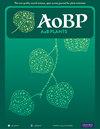巴西热带稀树草原树木以外的授粉现象:兰花 Zygopetalum mackayi 的新发现
IF 2.4
3区 生物学
Q2 ECOLOGY
引用次数: 0
摘要
在新热带地区,有性生殖研究的重点主要集中在巴西热带稀树草原的树木上,这些树木的特征主要是孢子体和面生,与多倍体和多胚胎有关。为了加深我们对热带草本植物无性繁殖和有性生殖机制的了解,我们阐明了附生兰 Zygopetalum mackayi 的无性繁殖、染色体数和多胚层之间的关系。为了确定胚胎起源并描述巨孢子发生和巨花粉发生,我们对栽培植物的首日花进行了人工自花授粉,并考虑了该物种的所有三种细胞型(2x、3x、4x)。我们收集了不同阶段的花和果实,以描述胚珠和种子的发育和形态,同时考虑有性和无性生殖过程。由于自花授粉处理导致二倍体果实流产率高,我们还考察了流产花和果实中花粉管的发育情况,以寻找可能的异常。巨孢子发生和巨花粉发生在所有细胞型中都有规律地发生。多倍体细胞型具有表面性和孢子体性,而二倍体个体只进行有性生殖。多胚性主要是由三倍体和四倍体的核细胞产生的不定胚引起的,但在所有细胞型中也有多孢子体的发育。与巴西热带草原上的其他无花果被子植物一样,我们的研究结果表明,马卡伊杉的无花果混交依赖于授粉者的种子生产。我们还从栖息地丧失及其对传粉者的依赖性的角度考虑了马卡伊荠的这些无花果模式对生态的影响。本文章由计算机程序翻译,如有差异,请以英文原文为准。
Apomixis beyond trees in the Brazilian savanna: new insights from the orchid Zygopetalum mackayi
In the Neotropics, the focus of apomictic studies predominantly centres on trees within the Brazilian savanna, characterized, mostlyas sporophytic and facultative, associated with polyploidy and polyembryony. To enhance our understanding of the mechanisms governing apomixis and sexual reproduction in tropical herbaceous plants, we clarify the relationship between apomixis, chromosome counts, and polyembryony in the epiphytic orchid Zygopetalum mackayi, which forms a polyploid complex within rocky outcrops in both the Brazilian savanna and the Atlantic forest. To define embryo origins and describe megasporogenesis and megagametogenesis, we performed manual self-pollinations in first-day flowers of cultivated plants, considering all three cytotypes (2x, 3x, 4x) of this species. Flowers and fruits at different stages were collected to describe development and morphology of ovule and seed considering sexual and apomictic processes. As self-pollination treatments resulted in high fruit abortion in diploids, we also examined pollen tube development in aborted flowers and fruits to search for putative anomalies. Megasporogenesis and megagametogenesis occur regularly in all cytotypes. Apomixis is facultative and sporophytic, and associated with polyploid cytotypes, while diploid individuals exclusively engage in sexual reproduction. Polyembryony is caused mainly by the production of adventitious embryos from nucellar cells of triploids and tetraploids, but also by the development of multiple archesporia in all cytotypes. Like other apomictic angiosperms within the Brazilian savanna, our findings demonstrate that apomixis in Z. mackayi relies on pollinators for seed production. We also consider the ecological implications of these apomictic patterns in Z. mackayi within the context of habitat loss and its dependence on pollinators.
求助全文
通过发布文献求助,成功后即可免费获取论文全文。
去求助
来源期刊

AoB Plants
PLANT SCIENCES-
CiteScore
4.80
自引率
0.00%
发文量
54
审稿时长
20 weeks
期刊介绍:
AoB PLANTS is an open-access, online journal that has been publishing peer-reviewed articles since 2010, with an emphasis on all aspects of environmental and evolutionary plant biology. Published by Oxford University Press, this journal is dedicated to rapid publication of research articles, reviews, commentaries and short communications. The taxonomic scope of the journal spans the full gamut of vascular and non-vascular plants, as well as other taxa that impact these organisms. AoB PLANTS provides a fast-track pathway for publishing high-quality research in an open-access environment, where papers are available online to anyone, anywhere free of charge.
 求助内容:
求助内容: 应助结果提醒方式:
应助结果提醒方式:


